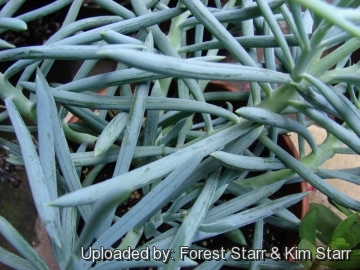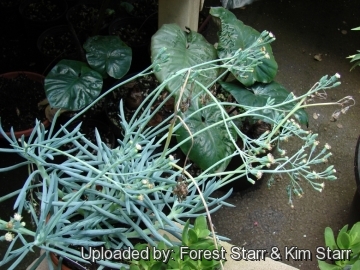
Senecio talinoides subs. mandraliscae Photo by: Forest Starr & Kim Starr
Flowering habit at Omaopio, Maui, Hawaii (USA). May 18, 2009.
Origin and Habitat: Senecio talinoides subs. mandraliscaeSN|18203]]SN|18203]], was originally described by Tineo from a plant growing in the Lipari Island (Sicily, Italy), but the origin of this plant is uncertain and a may be a garden hybrid.
Synonyms:
See all synonyms of Senecio talinoides
Common Names include:
ENGLISH: Blue Chalk Sticks, Blue finger, Bluefinger, Blue stick succulent
Description: The blue chalk sticks, Senecio talinoides subs. mandraliscaeSN|18203]]SN|18203]], is a mysterious taxon, probably hybrid, distinguished from the standard Senecio talinoidesSN|27676]]SN|19303]] by a marked juvenile phase characterized by short branches and short leaves more similar to those of Senecio citriformisSN|19303]]SN|27676]] 5-8 times as long as wide, later elongating. It is the bluest of the "talinoides" with a waxy white coating that protects it from hot, sunny, and dry conditions.
Habit: It is a glabrous, pruinose, evergreen perennial erect or semi-trailing succulent shrub typically less than 40 cm tall and 60 (or more) cm wide with leaves angled upward from the ground. It is the lower growing of the subspecies.
Stem: Branched, long, tubular, stout. Fleshy, erect becoming procumbent and often rooting at the nodes and brittle, 5-10 mm in diameter, usually short but occasionally up to 150 cm long in cultivation.
Leaves: Encircling the trailing stems or reduced to tufts at the stem tips, long fusiform to cylindrical-terete or laterally compressed, erect or arching, very fleshy, with a long mucro, 7-15 cm long, 8-13 mm in diameter, glaucous-grey with darker stripes, but can rub off the pruine and it's a blue-green beneath.
Inflorescence: Corymbose or paniculate with 10-25 small ray-less capitula (flower heads) held above the foliage. The outside of the capitulum is blue-green, and the small flowers within are white or off-white and not showy. Capitula 5-9 mm in diameter. Involucre 9-12 mm, with 2-5 supplementary bracts. Phyllaries 6 – 8. Disc florets 7-20.
Fruits: The fruits called achenes (or cypselas) are long and thin and have a conspicuous feathery pappus attached that functions as a "parachute" which enables the seed to be dispersed by the wind.
Chromosome number: The chromosome number of Senecio talinoides subs. mandraliscaeSN|18203]]SN|18203]] is variable ( 2n = 30 and 2n = 100).
Subspecies, varieties, forms and cultivars of plants belonging to the Senecio talinoides group
 Senecio talinoides (DC.) Sch.Bip.: (subsp. talinoides) Similar to Senecio talinoides subsp. mandraliscae but with finer texture. Distribution: Western Cape, Karoo.
Senecio talinoides (DC.) Sch.Bip.: (subsp. talinoides) Similar to Senecio talinoides subsp. mandraliscae but with finer texture. Distribution: Western Cape, Karoo.- Senecio talinoides subs. aizoides (DC.) G.D.Rowley: has 2-8 capitula per inflorescence, about 12 phyllaries and 25-30 disc florets. Distribution: Western Cape, South of Albertina.
- Senecio talinoides subs. chordifolius (Hook.f.) G.D.Rowley: has the longest leaves 17-18 cm long and dropping. Phyllaries about 17. Distribution: Western Cape, Prince Albert Distr.
 Senecio talinoides f. cristatus: crested form.
Senecio talinoides f. cristatus: crested form. Senecio talinoides subs. cylindricus (A.Berger) G.D.Rowley: has terete leaves, 10-15 capitula per inflorescence, 6-8 phyllaries and 7-20 disk florets. Distribution: Eastern Cape, East London and Alexandria Distr.
Senecio talinoides subs. cylindricus (A.Berger) G.D.Rowley: has terete leaves, 10-15 capitula per inflorescence, 6-8 phyllaries and 7-20 disk florets. Distribution: Eastern Cape, East London and Alexandria Distr. Senecio talinoides subs. mandraliscae (Tineo) G.D.Rowley: at first it has shortly fusiform leaves 5-8 mm as long as wide, later elongating. Capitula 10-25 per inflorescence, phyllaries 6-8, disk florets 7-20. Distribution: unknown
Senecio talinoides subs. mandraliscae (Tineo) G.D.Rowley: at first it has shortly fusiform leaves 5-8 mm as long as wide, later elongating. Capitula 10-25 per inflorescence, phyllaries 6-8, disk florets 7-20. Distribution: unknown
Bibliography: Major references and further lectures
1) Forest & Kim Starr “Senecio mandraliscae (Blue finger)”. Plants of Hawaii. <http://www.starrenvironmental.com>. Web. 27 Sep. 2014.
2) Debra Lee Baldwin “Succulent Container Gardens: Design Eye-Catching Displays with 350 Easy-Care Plants” Timber Press, 20/Jan/2010
3) Urs Eggli “Illustrated Handbook of Succulent Plants: Dicotyledons” Springer Science & Business Media, 2002
4) Gordon D. Rowley “Flowering succulents” Living Colour Publications, 1959
5) Gordon D. Rowley “Succulent Compositae: A Grower's Guide to the Succulent Species of Senecio und Otbonna" Strawberry Press, 1994
6) Hermann Jacobsen “A Handbook of Succulent Plants: Ficus to Zygophyllum” Blandford Press, 1960
7) Jacobsen “Lexicon of succulent plants” Littlehampton Book Services Ltd. 1974
8) Werner Rauh “The Wonderful World of Succulents: Cultivation and Description of Selected Succulent Plants Other Than Cacti” Smithsonian Institution Press, 1984
9) San Marcos Growers contributors “Senecio mandralicae (Kleinia)”. San Marcos Growers <http://www.smgrowers.com>. Web. 27 Sep. 2014.
10) "The Succulent Senecios of South Africa". The Guide to Life, The Universe and Everything. 2003
11) James Cullen, Sabina G. Knees, H. Suzanne Cubey “The European Garden Flora Flowering Plants: A Manual for the Identification of Plants Cultivated in Europe, Both Out-of-Doors and Under Glass” Cambridge University Press, 11/Aug/2011
12) Gideon Smith, Neil R. Crouch “Guide to Succulents of Southern Africa” Struik Nature, 01/Nov/2009
 Leaves at Kula Ace Hardware and Nursery, Maui, Hawaii (USA). September 06, 2007 Photo by: Forest Starr & Kim Starr
Leaves at Kula Ace Hardware and Nursery, Maui, Hawaii (USA). September 06, 2007 Photo by: Forest Starr & Kim Starr Flowers at Kula Ace Hardware and Nursery, Maui, Hawaii (USA). September 06, 2007. Photo by: Forest Starr & Kim Starr
Flowers at Kula Ace Hardware and Nursery, Maui, Hawaii (USA). September 06, 2007. Photo by: Forest Starr & Kim Starr Flowering habit at Kula Ace Hardware and Nursery, Maui, Hawaii (USA). September 06, 2007. Photo by: Forest Starr & Kim Starr
Flowering habit at Kula Ace Hardware and Nursery, Maui, Hawaii (USA). September 06, 2007. Photo by: Forest Starr & Kim StarrSend a photo of this plant.The gallery now contains thousands of pictures, however it is possible to do even more. We are, of course, seeking photos of species not yet shown in the gallery but not only that, we are also looking for better pictures than those already present.
Read More... Cultivation and Propagation: This plant grows as a groundcover and makes a very ornamental pale blue colouring in full sun in warm climates. It's fresh new winter growth provides extraordinary form and colour contrast in the landscape when placed either with other succulents (e.g. yellow Sedum) or in a mixed planting to contrast with anything orange, from terracotta pots to California poppies. It also pairs beautifully with red-leaved aloes, lavender 'After-glow' echeverias, fire sticks (Euphorbia tirucalliSN|23187]]SN|23187]]`Sticks on Fire'), elephant's food (Portulacaria afraSN|18165]]SN|18165]] f. variegata), and burgundy-leaved “Aeonium arboreumSN|149]]SN|149]] var. atropurpureum cv. Schwarzkopf (Zwartkop)”; and with nonsucculent companion plants such as ivy geranium, parrot's beak, and African daisies (Gazania species). It is drought tolerant, but will accept irrigation. Similar in appearance but not as common is Senecio serpensSN|18205]]SN|23938]], which is a better choice, if you can find it, for small beds and containers. Leaves are less than half the length of those of Senecio mandraliscaeSN|18205]]SN|18205]].
Soil: It requires a very free draining enriched soil, mildly acidic to mildly alkaline but is very tolerant of poor soils.
Watering: It needs moderate water during from spring to autumn, keep rather dry in winter or the plants may rot at the base. But it adapts to different growing conditions from extreme heat and drought, to high moisture as it has a low rot potential.
Exposition: They seem to do well in part shade such as at the base of trees, but thrives also in hot sunny positions and will tolerate coastal conditions.
Frost Tolerance: It is cultivated in open air in the tropical and warm Mediterranean climate, with temperatures which it is good to keep over the 5°C, best 10-12°C, but can withstand light frost for short periods if very dry (hardy down to -2 to -10º C, even if with damage to the foliage) in these situations it will better resist if sheltered by the winter rains, seen that the humidity and low temperatures render it more sensitive to rottenness. Plants in containers however, suffered major leaf loss. USDA Zone 9b to 12.
Wind and salt tolerance: Tolerates well high wind and second line salt wind.
Maintenance: The flower stems need to be removed to keep a tidy appearance. These species do tend to get sort of leggy, which is particularly a problem if grown as a potted plant, and yearly trimming back is often necessary. Cut back in late summer. Because old leaves fall off and new ones grow at the ends of the stems, Senecio mandraliscaeSN|23938]]SN|18205]] becomes lanky unless made to branch.
Propagation: It is easy to propagate by cuttings in late spring to summer, just take a cutting of the plant let it dry for 1 or 2 weeks and stuff it in the ground (preferably dry, loose, extremely well draining soil). Once established this pant provides a source of cuttings to give away or to fill gaps in the garden.













